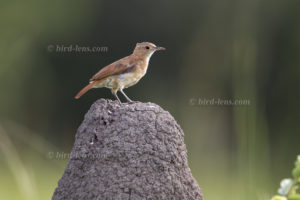 The Rufous Hornero (Furnarius rufus) is so common in the Pantanal, that you hardly think of taking a picture, as you think, that you will do it next day. Ok, this time some pictures were shot, when the bird was standing on a termite mound. There is some examination ungoing to study the interaction between birds and termites in Brazil. A study found 218 bird species feeding on termites or using termitaria for nesting or perching . The study found out, that termites are used as a food source are exploited as a nest site for some bird species as well. Some bird species also perch on the top of termite mounds to search for their prey or to conduct territorial or courtship displays.
The Rufous Hornero (Furnarius rufus) is so common in the Pantanal, that you hardly think of taking a picture, as you think, that you will do it next day. Ok, this time some pictures were shot, when the bird was standing on a termite mound. There is some examination ungoing to study the interaction between birds and termites in Brazil. A study found 218 bird species feeding on termites or using termitaria for nesting or perching . The study found out, that termites are used as a food source are exploited as a nest site for some bird species as well. Some bird species also perch on the top of termite mounds to search for their prey or to conduct territorial or courtship displays.
The Rufous Hornero is one – or the best-known- of the Ovenbirds and is from the same family as the Woodcreepers or the Spinetails. The bird looks a bit like a thrush but is very plain with a dirty white supercilium and a rather long, slightly curved bill.
The Rufous Hornero is often seen on the ground collecting mud or dung to build its remarkable nest. The nest look like miniature versions of the type of oven (or “horno”) that you see outside many houses in rural South America. Hence the name “Ovenbirds” in English and “Hornero”. This is the Spanish word for baker.
These nests are built in prominent positions in trees or on any suitable man-made object such as telephone or electricity posts. The nests consist of two chambers so that the 3 to 4 chicks are protected from predators and the wind – in most cases the entrance faces away from the prevailing wind. Like most non-tropical birds in South America, eggs are laid in about September and the building of the mud nest depends on there being sufficient rain to produce the mud but rain that is not so heavy that it washes away the nest as it is being built.
A pair of Rufous Hornero will only use their nest for one season but, because the sun-baked mud is extremely hard, it can last for several years and abandoned nests may be used by a variety of other birds. There are illustrations in Ridgely & Tudor, The Birds of South America: Vol. II, the Suboscine Passerines, Plate 2, which shows the bird very well.
The location of the photo-shot was not far from the farm Pouso Alegre. This is a pousada which is very well situated 7 km away from the Transpantaneira. The location is only 33 km south of Pocone in the northern Pantanal. The hole pousada is a great nature-area with original landscape and extensive cattle ranching. A paradise for the keen birdwatcher as well as for the beginner in birdwatching.
The owner is present much of the time, and is a dedicated naturalist. If you are birders you will be pleased with the birding opportunities, including Hyacinth Macaws in front of the porch. On the way you will see of Jabiru storks, herons and raptors a lot. You can go on other guided hikes or horseback rides. It’s all custom and small-scale. The scenery is beautiful.
The study with the name “Bird-termite interactions in Brazil: A review with perspectives for future studies” is focusing on all interactions between both animal groups. Because little is known about the identification of termite genera or species. Therefore, the study suggests more detailed studies to be conducted on the natural history and ecology of interactions between birds and termites in Brazil.
Bird-lens is mainly a website to suit the growing demand for top shots of the species of the Western Palearctic. But of interest is the phenomenon of bird migration in general. Trips to tourist and non-tourist spots like Thailand or the Seychelles to capture images of rare migrating birds are part of the program and were already very successful. More nice images you find in the gallery or in the “Pictures Shop”. Just give me a message, if Bird-lens could serve you with images also outside the range of the Western Palearctic. Images of e.g. South America are well on stock, too. The nice images you find in in the gallery are only a first impression, what you might find in the gallery in the “Picture Shop” too. Just give bird-lens.com a message, if bird-lens.com could serve you with an image needed before other pictures are online.